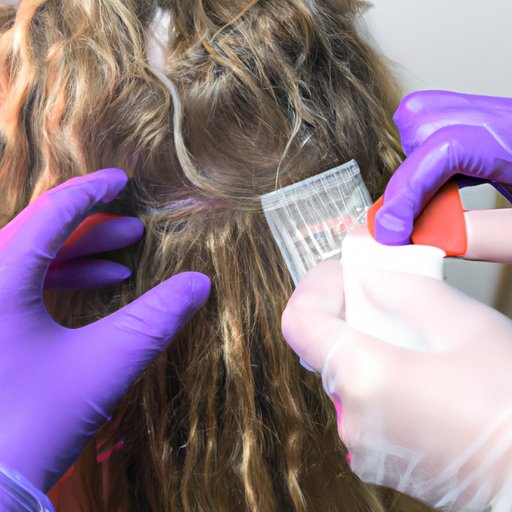
Introduction
Lice infestations are a common and uncomfortable problem that can affect people of all ages. These tiny insects feed on human blood and can cause severe itching and discomfort, as well as more severe infections in some cases. Regular lice checks are essential for early detection and prevention of infestations.
Why Checking Lice Matters
Lice infestations are characterized by intense itching of the scalp, neck, and ears. Other symptoms may include redness, inflammation, and the presence of lice eggs or nits in the hair. If left untreated, lice infestations can result in a range of complications, including infections, hair loss, and even the spread of disease.
Early detection is key to stopping lice infestations from spreading and becoming more severe. Regular lice checks can help identify and address infestations quickly and effectively.
7 Techniques for Lice Inspection
There are several techniques for checking for lice infestations. Some of the most effective methods include:
Method 1: Wet Comb Technique
The wet comb technique is one of the most popular and effective methods for checking for lice. It involves using a special lice comb to comb through wet hair and remove any lice or eggs that are present. Here are the steps to follow:
- Wet hair and apply conditioner.
- Comb hair slowly from root to tip with a lice comb.
- Wipe comb on a tissue or paper towel after each pass.
- Repeat process until you have combed all sections of the head.
- Rinse hair thoroughly.
Precautions to consider: Always use a clean comb. Remove any visible nits or lice from the comb thoroughly after each pass.
Method 2: Visual Checking
Visual checking is another effective method for finding lice. It involves visually inspecting the scalp and hair for any signs of lice or eggs, including pinpointing small brown or white nits on the hair stands. Here are the steps to follow:
- Divide the hair into small sections and examine each section carefully for lice or nits.
- Focus on areas behind the ears, at the base of the neck, and around the hairline.
- Use a magnifying glass or a headlamp, if necessary.
- Remove any visible nits or lice with a comb.
Precautions to consider: Visual inspection might be difficult to do for those with thick and long hair.
Method 3: Blow Drying Technique
Blow drying is another method that can help detect lice and eggs. This method works by desiccating the lice and eggs with warm air. Here are the steps to follow:
- Wet and condition hair.
- Blow-dry hair using a high heat setting but avoiding the scalp.
- Use a brush to notice and remove any visible nits or lice.
Precautions to consider: Be cautious not to hold the blow dryer too close to the scalp.
Method 4: Black Light Technique
The black light technique involves using a special black light to illuminate the hair and detect lice and eggs. Here are the steps to follow:
- Darken the room.
- Part hair into thin sections.
- Shine a black light on each section.
- Look for glowing yellow-white nits or lice.
Precautions to consider: Black lights may not detect all lice and eggs, and it does not kill them.
Method 5: Vinegar Method
The Vinegar method involves using vinegar to loosen the glue which holds lice eggs to the hair shafts. Here are the steps to follow:
- Mix half vinegar and half water in a spray bottle.
- Spray mixture on wet hair until its completely saturated.
- Use a shower cap and leave on for two hours or overnight.
- Rinse hair with warm water.
- Comb hair carefully with a lice comb to remove any dead lice or nits.
Precautions to consider: Vinegar may be a bit harsh, on sensitive scalp or even cause irritation.
Method 6: Professional Inspection
Professional lice inspection is an option when you are unable to get the job done correctly on your own. A professional lice inspector can systematically check your hair and scalp for lice infestations and nits. Here are some tips for finding a reputable professional:
- Check online reviews.
- Ask for referrals.
- Look for a company that has certified technicians.
- Go through the tools that they use and ensure they’re sterilized machines.
Method 7: Self-inspection
You can always perform the lice checks on yourself, friends, or family members. Here’s how:
- Use a mirror to check the hair close to the scalp.
- Use a magnifying glass or headlamp to help you.
- Dividing hair into sections and examining each section for lice
Tips and Tricks for Accurate and Efficient Lice Checks
Regular lice checks can help detect and prevent infestations, but there are also some tips and tricks to ensure accuracy and efficiency during the process:
- Check hair at least once a week.
- Comb hair while wet and dipped in a mix of vinegar and mint oil.
- Check for hair that is stuck to the scalp, where lice usually lay their egg/nit.
- Disinfect all combs and brushes after each use with rubbing alcohol.
There are several over-the-counter treatments available, but they are not always efficacious to nip the problem at the bud. There is no overnight solution for lice treatment; consistency and patience is key.
Conclusion
Lice inspections are essential for detecting lice infestations early to prevent further issues. Comb out with a lice comb and check weekly is necessary. Use the tips and tricks mentioned earlier to check for lice for accuracy and efficiency. Preventing the spread of lice and curing it takes time, effort, and the correct treatment method for the individual.





